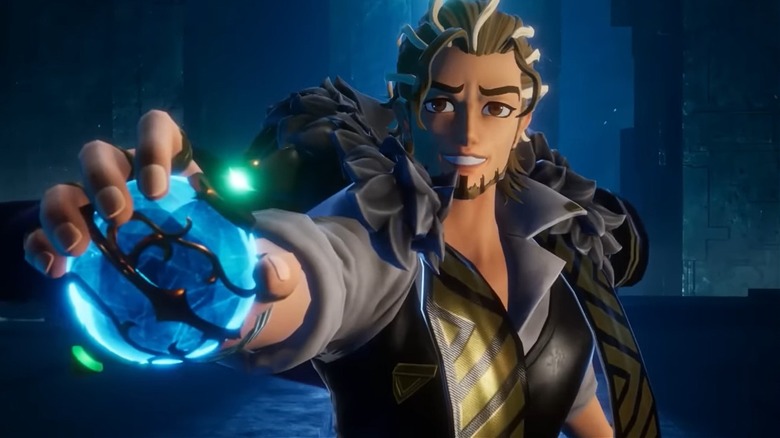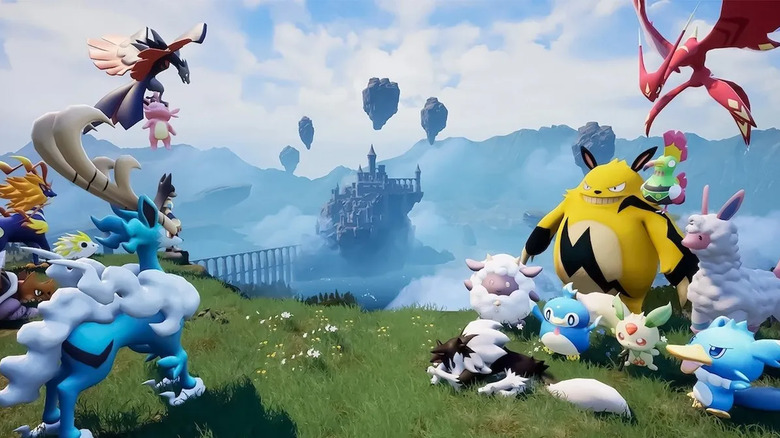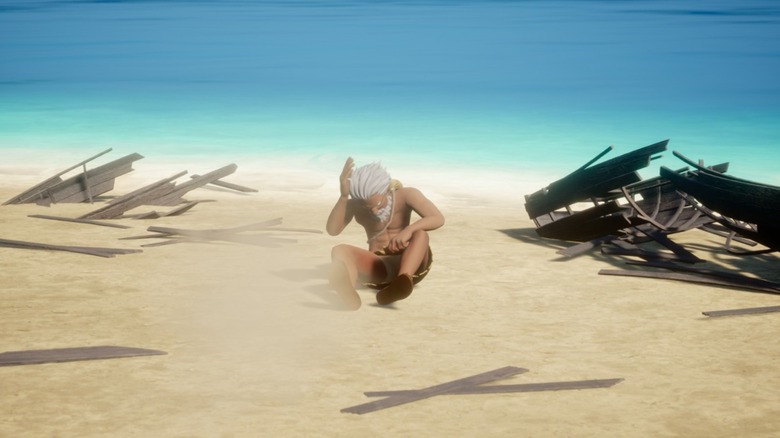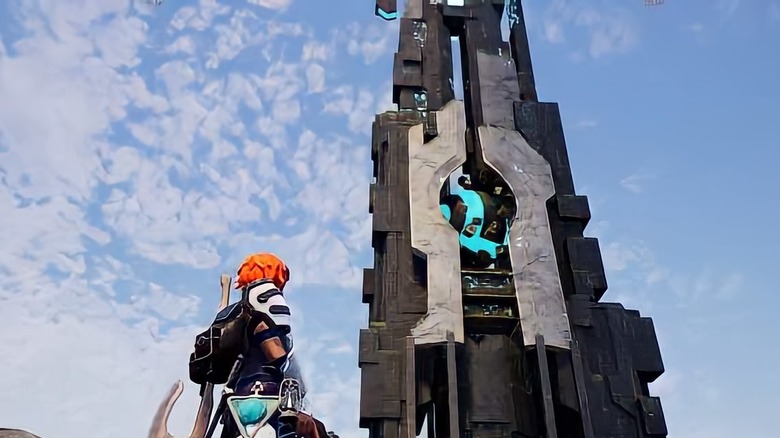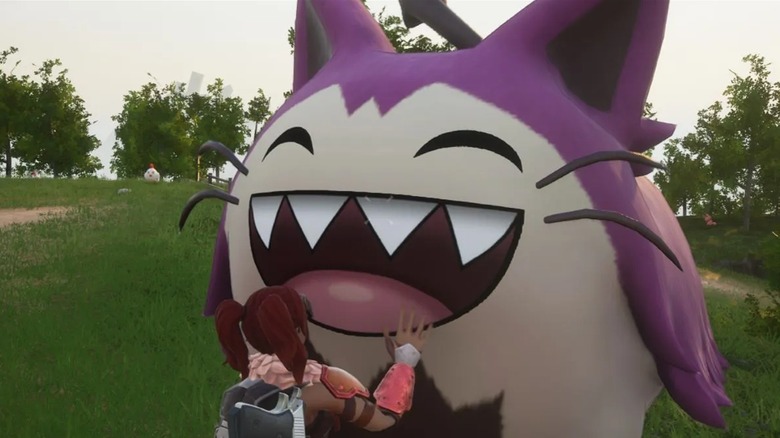Palworld's Biggest Unanswered Questions
"Palworld" has caught on quick with gamers, selling millions of copies on the hilariously bankable premise of "Pokémon with guns." However, after spending a few hours with the game, players may come to realize that there is much more to it than that. Scattered about the Palpagos Islands are diary entries and in-the-know NPCs which provide a bit of helpful exposition about the world around you. Even so, these really only offer the faintest idea of the overarching story, which has led some critics to slam the game's storytelling for its sparseness — but it's there.
There's still a lot we don't know about the Palpagos Islands and the secret history of the Pals. As expected, fans have taken hold of these small morsels of lore and started speculating wildly, hoping to fill in the gaps. Here are some of the biggest unanswered questions in "Palworld," along with some tantalizing fan theories.
When and where does Palworld take place?
"Palworld" contains multiple hints suggesting that the inhabitants of the Palpagos Islands have come to this place from all across time. The Castaway's journal (which is found in pieces around the island) not only theorizes about the ancient civilization that built the islands' various ruins, but also references weaponry and clothing from their own era. Some characters seem to have almost regressed to a feral state, while others speak plain modern day dialects and operate futuristic tech. These discrepancies, along with the Castaway's references to a giant tree reminiscent of the mythological Worldtree (or even the Erdtree from "Elden Ring"), seem to suggest that these aren't just your average uncharted islands.
There are several fan theories about the true nature of the Palpagos Islands. One theory holds that the game takes place in the far future, with the area being populated by time-displaced travelers. It's also possible that the islands may exist outside of the world as we know it, acting as a waypoint between various realities or timelines. Perhaps — follow us here — the Palpagos Islands are even a kind of purgatory. After all, it seems some people who arrive in this hidden archipelago either have hazy memories or have just been through a traumatic shipwreck before finding themselves suddenly washed up on the beach.
Sadly, the players who have managed to reach the giant tree have not found anything of interest to lore-hunters, let alone an explanation of the island as a whole. Until Pocketpair reveals more about the so-called Worldtree and the Castaway, the theories about the world's true history are only likely to get weirder.
How did the protagonist arrive?
"Palworld" begins with the game's protagonist seemingly washing up on a beach and finding that they are surrounded by curious Pals. The protagonist stands up and finds a mysterious tablet — the Paldeck — laying on the sand before them. Naturally, they pick up the tablet and set off to explore this strange new island, as anyone would do in this situation. It can be assumed that the protagonist was caught in a storm and crashed on the Palpagos Islands, but it's never said outright. Upon waking, the protagonist is surrounded by what appear to be the broken pieces of various seafaring vessels, but the wreckage looks too old and partially buried to belong to them.
So where (and when) is the player character from? Pocketpair doesn't offer much at all in the way of backstory, allowing players to project themselves onto protagonist (and do some messed-up things in the process). This makes the game a lot of fun from an RPG standpoint, but from a storytelling standpoint, it raises several questions. Is it possible that the protagonist knew the Castaway and somehow forgot them? Why else would they be trusted with the Paldeck? Could the protagonist even be the Castaway, suffering from memory loss after a failed attempt to leave the Palpagos Islands?
What's the FPA's problem?
The influence of the Free Pal Alliance can be felt all over the map in "Palworld." Judging from their name, the militia group would seem to have a noble mission of freeing the island's Pals from human tyranny, making sure that people like the protagonist can no longer capture or butcher Pals. However, "Palworld" players have noticed that a lot of the FPA's behavior would seem to clash with their stated goals.
For one thing, just about every Free Pal Alliance camp seems to be keeping Pals in cages — literally the opposite of freedom. Redditors have joked about this conundrum and have arrived at a few different conclusions. Some think the poor little guys are being held in captivity until the Alliance can introduce them back into the wild. Others have suggested that we're reading the name all wrong, with u/paperduck1 quipping, "They don't want to free the pals. They want FREE PALS." Making things even more unclear is the fact that they'll sometimes attack one another, seemingly for no reason. It's all very confusing, suggesting there may be a rift in the ranks of the Free Pal Alliance.
It's also worth noting that players can often find members of the FPA viciously attacking innocent Pals. No wonder you can find a gaggle of FPA members in a place called Hypocrite Hill.
Where did Pals really come from?
This may seem like a bizarre question for anyone who hasn't thought twice about the lore in "Palworld." After all, we don't usually ask too many questions about where Pokémon came from. However, "Palworld" players have no doubt encountered a number of journal entries that raise a whole heaping helping of questions about the origins of Pals. When you capture the birdlike Pal Robinquill, its Paldeck entry outright states, "A Pal that is very similar to humans who hunt and live in the forests. It may prove to be a key for understanding what Pals are and how they diverged from humans long ago." That's right; this entry suggests that Pals may have somehow evolved from the human race at some point in the distant past.
pals evolved from humans?!?! pic.twitter.com/1myuCkGD64
— Gene Park (@GenePark) January 23, 2024
Other journal pages reveal that at least some Pals were created by means of experimentation with living subjects, which could explain some of their abilities. But at what point did human evolution splinter off into animal-like creatures with elemental powers? Is it possible that the original Pals were also part of some unknown experiment — one that's been lost to time?

